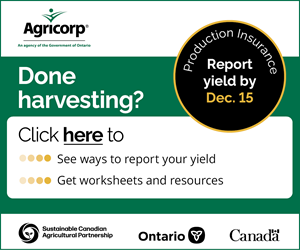Business side: Explaining the exchange rate
CONVERSATIONS WITH BUSINESS EXPERTS

Why should an Ontario farmer care about the Canadian dollar exchange rate?
Exchange rates reflect the value of different currencies relative to one another. As currency values fluctuate, so too do the prices of a country’s imports and the value of its exports. This in turn affects a farmer’s input costs, if they are purchasing supplies or equipment from another country. It can also impact farm revenue if they export to another country and the Canadian dollar (CAD) appreciates, their revenue decreases. If they import and the CAD depreciates, their costs increase. And that reduces revenue. Either way, revenue is impacted regardless of whether a farmer is an importer or exporter.
Why should grain farmers also be concerned about the value of another country’s currency?
For Canadian farmers, the relationship between the Canadian and US dollar is incredibly significant. This is because whatever is going on economically in the States affects markets and prices in Canada. Whether we like it or not, our two countries are connected at the hip. So even if everything was stable in Canada, activity in the US may have an impact on our exchange rates – either positively or negatively, depending on whether you’re buying or selling. For example, the withdrawal of the US Federal Reserve’s massive stimulus program should have a positive effect on the US dollar. In turn, this would weaken the loonie. A weaker Canadian dollar can have a positive impact on export revenues, at the same time that it makes imports more expensive.
I should also point out that currency fluctuations expose farmers to basis risk. Basis is the difference in the Chicago price for a US dollar valued commodity and the local price. Basis is affected by transportation costs, local supply and demand factors, as well as foreign exchange. A strengthening US dollar and a weakening loonie will have a positive impact on the basis.
What influences a change in exchange rates?
Central Bank actions have a significant impact. Right now, the Federal Reserve System, (also known as “The Fed”, in the US) is in the process of withdrawing economic stimulus – or “quantitative easing”. This will have an impact on Canadian and US currencies. But other forces, such as inflation, productivity and labour cost differentials – the difference between what, for example, manufacturing employees make in Canada versus America – influence exchange rates. Interest rates also play a part. If you raise interest rates you attract investment. This has a positive impact on currency value. Canada is also a commodity-based economy. When commodity prices rise, the Canadian dollar tends to rise with them.
What relationship do exchange rates have to commodity prices?
The value of a currency often reflects the prices of a country’s exports. Canada is a net exporter of a wide range of commodities, such as crude oil, base metals, and agricultural commodities. As such, broad-based increases in commodity prices have a positive effect on the value of those exports. In particular, the Canadian dollar is highly-linked to the global price of oil. If the price of oil goes up, the value of our oil exports goes up too; and that increases GDP and the value of our dollar.
Where do you see the Canadian dollar exchange rate going in six months? Longer-term? Is this good news for Ontario farmers?
Over the next nine months or so, TD sees the US dollar gaining strength. The last forecast published on July 4, 2013, is predicting a rise in the US dollar to $1.06 CAD by September, $1.09 CAD by December and $1.11 CAD by March, 2014. For exporters, this is good news as a stronger US dollar would have a positive impact on grain prices overall. And while it would have a potentially negative impact on input costs, you can not argue with the fact that America is our biggest customer. So if their economy is gaining momentum, it is ultimately good for Canada.
How often should a grain farmer update themselves on exchange rates?
Most farmers I know pay close attention to economic indicators. Watching prices and knowing when to lock in is part of their business. At TD, we prepare regular forecasts and updates geared to a variety of industries – including agriculture. And I know most of our customers are reading these. I know many farmers who check in daily because changes in the value of the Canadian dollar can seriously impact the profitability of their business. Agriculture is very active when it comes to managing foreign exchange risk, typically with forward contracts. They are playing it smart, and will lock in their rates and their profit margins when it is favourable to do so. Clients can contact our regional foreign exchange experts to discuss how best to manage their foreign exchange exposure.
I also recommend that people read the forecasts from TD Economics. Dollars and Sense is a monthly publication our Economics team produces. It is free and available online at TD.com/economics. TD Securities also publishes a monthly “Global Markets” newsletter that looks at both macro and micro conditions. I would also recommend speaking to one of our local TD Agriculture Account Managers. •






















